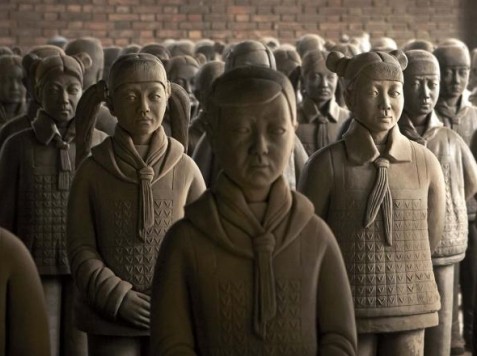
An artist’s new exhibition has drawn sharp attention to China’s controversial one-child policy. Introduced in 1979, the policy has markedly restructured Chinese society while it has also created dramatic impact on an entire generation that has been raised without brothers and sisters.
A recent report by BBC highlights a provocative new exhibit by French artist Prune Nourry. Entitled Terracotta Daughters, the exhibit is currently showing in Shanghai’s Gallery Magda Danysz, and uses as its template, the famous Terracotta Warriors, a collection of sculptures representing the armies of the first Emperor of China. Instead of a brigade of soldiers, however, Nourry has generated an army of schoolgirls, symbolizing China’s millions of missing women.
One of the models for Nourry’s exhibit is 12 year-old Huiyun, who, as BBC relates, began her life in the garbage. As an unwanted baby girl, Huiyun’s parents abandoned her in their poor province in central China. Two garbage collectors found her, however, with her umbilical cord still attached, and kept her, raising her as their own.
“I wanted to highlight the girls that are not cared about, by mixing them with a strong familiar symbol [the Terracotta Warriors],” explained Nourry. “When you change something slightly that everyone knows it creates something bizarre – and people want to know more.”
Nourry fashioned eight life-size sculptures based on real orphans for Terracotta Daughters. She then used combinations of these prototypes to create an additional 108 sculptures in collaboration with traditional Chinese craftsmen.
According to BBC, funds from the sales of the original eight sculptures will pay for three years’ education for each orphan in co-operation with NGO Children of Madaifu.
Because of its one-child policy, China has the most skewed sex ratio in the world, with 117 boys born for every 100 girls. Since the Chinese culture traditionally favors males, many female babies have been abandoned, murdered, and aborted. In 2000, for example, 90 percent of aborted babies were reportedly female.
By the end of this decade, China is expected to have a surplus of 24 million unmarried males, a factor that has led to concerns that the nation will experience an increase in kidnapping and trafficking of women as brides and, for lonely, single men with no hope of marriage and a family, a hike in gambling, depression, and alcohol abuse.
In addition, BBC reports that the Chinese Academy of Social Sciences estimates that more than one million parents in the nation have lost their only child, many of whom are either too old to have another child or have undergone, sometimes involuntarily, sterilization. A child’s death not only brings about grief, but also a sense of shame and fears of financial ruin as well, as most parents still depend on their children to support them in their senior years.
Other artists have joined Nourry in exploring the one-child policy and openly protesting it. Li Tianbing exhibited LC Body and Me and My Brother in London, paintings based on black and white photographs of himself as an only child, in which he painted in the imaginary siblings he never had.
Another artist, Xing Xin, locked himself in a 6 ½ feet x 3 feet iron box for 49 days at 2009’s Venice Biennale in protest of a policy he believes has infringed upon human rights.
Photo: PruneNourry/Zachary Bako/Courtesy of the Magda Danysz Gallery

COMMENTS
Please let us know if you're having issues with commenting.